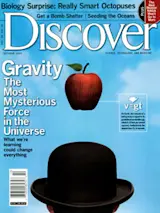In their many years of research, paleontologists Richard Fortey and Brian Chatterton have come across some mighty strange trilobites, ancient sea creatures that resembled a cross between a lobster and a beetle. They have seen trilobites with spines and ones with spikes, trilobites the size of a dime, and others as big as a dog. Yet Fortey, of the Natural History Museum in London, and Chatterton, of the University of Alberta in Canada, were stunned when a commercial fossil dealer in Morocco presented them with a beautiful specimen of Erbenochileerbeni, a one-and-a-half-inch-long trilobite with cylindrical eyes, each tiled with 560 lenses, that rose from the creature’s head like tiny quarter-inch periscopes. These unique eyes gave the animal the ability to see in all directions at once without turning its head.
Courtesy Phil Crabb, Natural History Museum, London
Erbenochile's towering eyes let it watch all around for predators and prey, while ...














